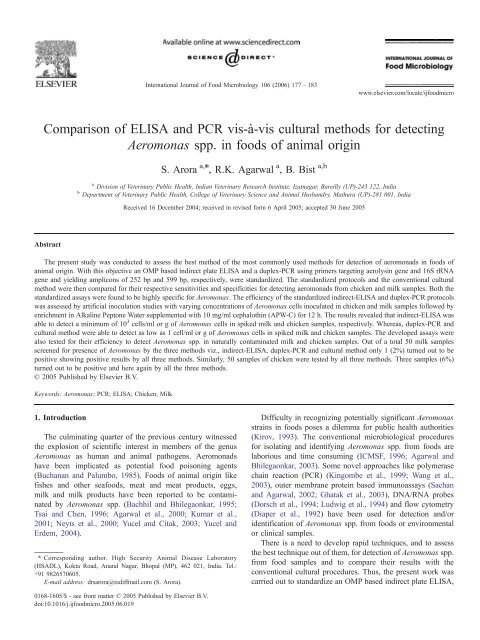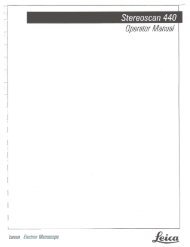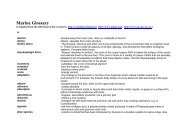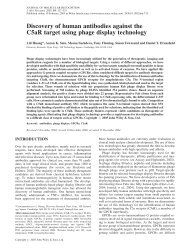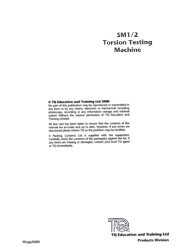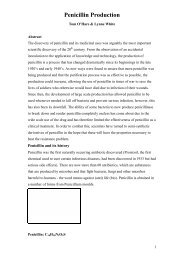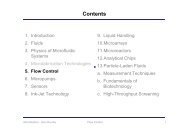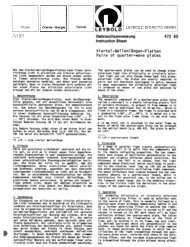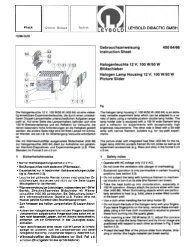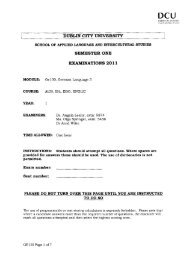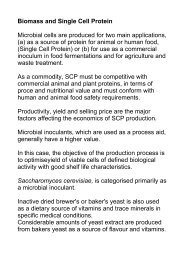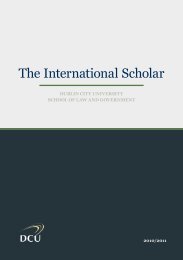Comparison of ELISA and PCR vis-a`-vis cultural methods for ...
Comparison of ELISA and PCR vis-a`-vis cultural methods for ...
Comparison of ELISA and PCR vis-a`-vis cultural methods for ...
Create successful ePaper yourself
Turn your PDF publications into a flip-book with our unique Google optimized e-Paper software.
<strong>Comparison</strong> <strong>of</strong> <strong>ELISA</strong> <strong>and</strong> <strong>PCR</strong> <strong>vis</strong>-à-<strong>vis</strong> <strong>cultural</strong> <strong>methods</strong> <strong>for</strong> detecting<br />
Aeromonas spp. in foods <strong>of</strong> animal origin<br />
Abstract<br />
S. Arora a, *, R.K. Agarwal a , B. Bist a,b<br />
a Di<strong>vis</strong>ion <strong>of</strong> Veterinary Public Health, Indian Veterinary Research Institute, Izatnagar, Bareilly (UP)-243 122, India<br />
b Department <strong>of</strong> Veterinary Public Health, College <strong>of</strong> Veterinary Science <strong>and</strong> Animal Husb<strong>and</strong>ry, Mathura (UP)-281 001, India<br />
Received 16 December 2004; received in re<strong>vis</strong>ed <strong>for</strong>m 6 April 2005; accepted 30 June 2005<br />
The present study was conducted to assess the best method <strong>of</strong> the most commonly used <strong>methods</strong> <strong>for</strong> detection <strong>of</strong> aeromonads in foods <strong>of</strong><br />
animal origin. With this objective an OMP based indirect plate <strong>ELISA</strong> <strong>and</strong> a duplex-<strong>PCR</strong> using primers targeting aerolysin gene <strong>and</strong> 16S rRNA<br />
gene <strong>and</strong> yielding amplicons <strong>of</strong> 252 bp <strong>and</strong> 599 bp, respectively, were st<strong>and</strong>ardized. The st<strong>and</strong>ardized protocols <strong>and</strong> the conventional <strong>cultural</strong><br />
method were then compared <strong>for</strong> their respective sensitivities <strong>and</strong> specificities <strong>for</strong> detecting aeromonads from chicken <strong>and</strong> milk samples. Both the<br />
st<strong>and</strong>ardized assays were found to be highly specific <strong>for</strong> Aeromonas. The efficiency <strong>of</strong> the st<strong>and</strong>ardized indirect-<strong>ELISA</strong> <strong>and</strong> duplex-<strong>PCR</strong> protocols<br />
was assessed by artificial inoculation studies with varying concentrations <strong>of</strong> Aeromonas cells inoculated in chicken <strong>and</strong> milk samples followed by<br />
enrichment in Alkaline Peptone Water supplemented with 10 mg/ml cephalothin (APW-C) <strong>for</strong> 12 h. The results revealed that indirect-<strong>ELISA</strong> was<br />
able to detect a minimum <strong>of</strong> 10 3 cells/ml or g <strong>of</strong> Aeromonas cells in spiked milk <strong>and</strong> chicken samples, respectively. Whereas, duplex-<strong>PCR</strong> <strong>and</strong><br />
<strong>cultural</strong> method were able to detect as low as 1 cell/ml or g <strong>of</strong> Aeromonas cells in spiked milk <strong>and</strong> chicken samples. The developed assays were<br />
also tested <strong>for</strong> their efficiency to detect Aeromonas spp. in naturally contaminated milk <strong>and</strong> chicken samples. Out <strong>of</strong> a total 50 milk samples<br />
screened <strong>for</strong> presence <strong>of</strong> Aeromonas by the three <strong>methods</strong> viz., indirect-<strong>ELISA</strong>, duplex-<strong>PCR</strong> <strong>and</strong> <strong>cultural</strong> method only 1 (2%) turned out to be<br />
positive showing positive results by all three <strong>methods</strong>. Similarly, 50 samples <strong>of</strong> chicken were tested by all three <strong>methods</strong>. Three samples (6%)<br />
turned out to be positive <strong>and</strong> here again by all the three <strong>methods</strong>.<br />
D 2005 Published by Elsevier B.V.<br />
Keywords: Aeromonas; <strong>PCR</strong>; <strong>ELISA</strong>; Chicken; Milk<br />
1. Introduction<br />
The culminating quarter <strong>of</strong> the previous century witnessed<br />
the explosion <strong>of</strong> scientific interest in members <strong>of</strong> the genus<br />
Aeromonas as human <strong>and</strong> animal pathogens. Aeromonads<br />
have been implicated as potential food poisoning agents<br />
(Buchanan <strong>and</strong> Palumbo, 1985). Foods <strong>of</strong> animal origin like<br />
fishes <strong>and</strong> other seafoods, meat <strong>and</strong> meat products, eggs,<br />
milk <strong>and</strong> milk products have been reported to be contaminated<br />
by Aeromonas spp. (Bachhil <strong>and</strong> Bhilegaonkar, 1995;<br />
Tsai <strong>and</strong> Chen, 1996; Agarwal et al., 2000; Kumar et al.,<br />
2001; Neyts et al., 2000; Yucel <strong>and</strong> Citak, 2003; Yucel <strong>and</strong><br />
Erdem, 2004).<br />
0168-1605/$ - see front matter D 2005 Published by Elsevier B.V.<br />
doi:10.1016/j.ijfoodmicro.2005.06.019<br />
International Journal <strong>of</strong> Food Microbiology 106 (2006) 177 – 183<br />
* Corresponding author. High Security Animal Disease Laboratory<br />
(HSADL), Kokta Road, An<strong>and</strong> Nagar, Bhopal (MP), 462 021, India. Tel.:<br />
+91 9826570605.<br />
E-mail address: drsarora@rediffmail.com (S. Arora).<br />
www.elsevier.com/locate/ijfoodmicro<br />
Difficulty in recognizing potentially significant Aeromonas<br />
strains in foods poses a dilemma <strong>for</strong> public health authorities<br />
(Kirov, 1993). The conventional microbiological procedures<br />
<strong>for</strong> isolating <strong>and</strong> identifying Aeromonas spp. from foods are<br />
laborious <strong>and</strong> time consuming (ICMSF, 1996; Agarwal <strong>and</strong><br />
Bhilegaonkar, 2003). Some novel approaches like polymerase<br />
chain reaction (<strong>PCR</strong>) (Kingombe et al., 1999; Wang et al.,<br />
2003), outer membrane protein based immunoassays (Sachan<br />
<strong>and</strong> Agarwal, 2002; Ghatak et al., 2003), DNA/RNA probes<br />
(Dorsch et al., 1994; Ludwig et al., 1994) <strong>and</strong> flow cytometry<br />
(Diaper et al., 1992) have been used <strong>for</strong> detection <strong>and</strong>/or<br />
identification <strong>of</strong> Aeromonas spp. from foods or environmental<br />
or clinical samples.<br />
There is a need to develop rapid techniques, <strong>and</strong> to assess<br />
the best technique out <strong>of</strong> them, <strong>for</strong> detection <strong>of</strong> Aeromonas spp.<br />
from food samples <strong>and</strong> to compare their results with the<br />
conventional <strong>cultural</strong> procedures. Thus, the present work was<br />
carried out to st<strong>and</strong>ardize an OMP based indirect plate <strong>ELISA</strong>,
178<br />
a duplex-<strong>PCR</strong> <strong>and</strong> to evaluate the suitability <strong>of</strong> the developed<br />
assays <strong>for</strong> detection <strong>of</strong> Aeromonas from foods <strong>of</strong> animal origin.<br />
The results <strong>of</strong> the developed assays were compared among<br />
themselves <strong>and</strong> with conventional <strong>cultural</strong> method.<br />
2. Materials <strong>and</strong> <strong>methods</strong><br />
2.1. Cultural method<br />
For isolation <strong>and</strong> identification <strong>of</strong> Aeromonas from food<br />
samples 12 h enrichment in Alkaline Peptone Water supplemented<br />
with 10 mg/ml cephalothin (APW-C) was done<br />
(Sachan <strong>and</strong> Agarwal, 2000) <strong>and</strong> growth plated on Ampicillin<br />
Dextrin Agar (ADA). After 24 h incubation at 37 -C the<br />
characteristic colonies were confirmed biochemically (Agarwal<br />
et al., 2003b).<br />
2.2. Indirect plate <strong>ELISA</strong><br />
2.2.1. Preparation <strong>of</strong> crude OMP<br />
The crude outer membrane protein (OMP) was extracted<br />
from the st<strong>and</strong>ard strain <strong>of</strong> Aeromonas hydrophila subsp.<br />
hydrophila (Microbial Type Culture Collection Strain No.<br />
646, MTCC 646) as per the method <strong>of</strong> Crosa <strong>and</strong> Hodges<br />
(1981) as modified by Santos et al. (1996) <strong>and</strong> Sachan <strong>and</strong><br />
Agarwal (2002). Briefly, A. hydrophila subsp. hydrophila<br />
was grown overnight in 100 ml <strong>of</strong> tryptone soya broth<br />
(TSB). The cells were recovered by centrifugation at<br />
5000 g <strong>for</strong> 30 min at 4 -C. Cells were resuspended in 3<br />
ml <strong>of</strong> 10 mM tris (hydroxyl methyl) amino methane buffer<br />
containing 0.3% (w/v) NaCl (pH 8.0) <strong>and</strong> sonicated with a<br />
MSE Sanyo Sonicator <strong>for</strong> 3 times at 10 Am amplitude <strong>for</strong> 45<br />
s. After centrifugation at 10,000 g <strong>for</strong> 2 min, the<br />
supernatant was transferred to new tubes <strong>and</strong> centrifuged<br />
<strong>for</strong> 1 h at 17,000 g at 4 -C. Resulting pellets <strong>of</strong> cell<br />
envelop suspensions were incubated overnight at 4 -C with<br />
3% (w/v) sodium lauroyl sarcosinate (sarkosyl) in 10 mM tris<br />
buffer. Outer membrane protein was obtained by centrifugation<br />
at 17,000 g <strong>for</strong> 1 h <strong>and</strong> washed twice with distilled<br />
water. The OMP was stored at 20 -C.<br />
The protein content <strong>of</strong> OMP was determined as outlined by<br />
Schacterle <strong>and</strong> Pollack (1973) with little modifications.<br />
Concisely, 5 Al <strong>of</strong> OMP was diluted with 295 Al <strong>of</strong>DWina<br />
test tube. Different concentrations (10 Ag, 60 Ag, 120 Ag, 180<br />
Ag, 240 Ag <strong>and</strong> 300 Ag) <strong>of</strong> bovine serum albumin (BSA) were<br />
prepared in 1% (w/v) sodium dodecyl sulfate (SDS) to a total<br />
volume <strong>of</strong> 300 Al. To all the tubes 1.2 ml <strong>of</strong> 2 Lowry<br />
concentrate was added <strong>and</strong> incubated at room temperature <strong>for</strong><br />
10 min. Thereafter 0.6 ml <strong>of</strong> Folin reagent was added <strong>and</strong><br />
incubated at 55 -C <strong>for</strong> 5 min. The absorbance was measured at<br />
750 nm. Protein concentration <strong>of</strong> OMP was determined from<br />
the st<strong>and</strong>ard graph drawn <strong>for</strong> optical density <strong>of</strong> BSA against<br />
different concentrations.<br />
2.2.2. Production <strong>of</strong> antiserum against crude OMP<br />
Antiserum against crude OMP <strong>of</strong> A. hydrophila subsp.<br />
hydrophila (MTCC 646) was raised in an adult rabbit as per the<br />
S. Arora et al. / International Journal <strong>of</strong> Food Microbiology 106 (2006) 177–183<br />
method described by Santos et al. (1996) <strong>and</strong> Sachan <strong>and</strong><br />
Agarwal (2002). OMP (500 Ag protein) was emulsified with an<br />
equal volume <strong>of</strong> Freund’s complete adjuvant (FCA, Difco). A<br />
rabbit was injected subcutaneously in divided doses at various<br />
dorsal sites. Booster dose was given after 15 days with OMP<br />
(250 Ag protein) emulsified with equal volume <strong>of</strong> Freund’s<br />
incomplete adjuvant (IFCA, Difco) followed by a similar<br />
booster dose after another 15 days. Rabbit were bled 2 weeks<br />
after the last immunization. Preimmune serum was used as<br />
control serum.<br />
2.2.3. St<strong>and</strong>ardization <strong>of</strong> indirect plate <strong>ELISA</strong><br />
The indirect plate <strong>ELISA</strong> was per<strong>for</strong>med as per the <strong>methods</strong><br />
described by Engvall <strong>and</strong> Perlman (1971), Sachan <strong>and</strong> Agarwal<br />
(2002) <strong>and</strong> Ghatak et al. (2003) with suitable modifications.<br />
The test was st<strong>and</strong>ardized by checker board analysis. The<br />
optimum titre <strong>of</strong> anti-OMP serum was found 1:1600 <strong>and</strong> thus<br />
1:800 dilution was used in further studies.<br />
2.3. Duplex-polymerase chain reaction<br />
2.3.1. Preparation <strong>of</strong> DNA template<br />
DNA template was prepared by boiling followed by snap<br />
chilling into ice. One hundred microliters <strong>of</strong> the broth<br />
culture was taken <strong>and</strong> centrifuged at 5000 g <strong>for</strong> 5 min.<br />
The pellet was resuspended in 100 Al PBS. This step was<br />
repeated once <strong>and</strong> the resulting pellet dissolved in PBS was<br />
subjected to vigorous heating in a boiling water bath <strong>for</strong><br />
about 8 min <strong>and</strong> then immediately snap chilled into ice.<br />
From this snap chilled lysate, 3 Al was used as template<br />
source in <strong>PCR</strong>.<br />
2.3.2. Oligonucleotide primers<br />
The primers <strong>for</strong> 16S rRNA <strong>and</strong> aerolysin genes <strong>of</strong><br />
Aeromonas spp. used in this study were got synthesized from<br />
Bangalore Genei. The details <strong>of</strong> primers used <strong>and</strong> their<br />
corresponding amplicons are given in Table 1.<br />
2.3.3. St<strong>and</strong>ardization <strong>of</strong> duplex-<strong>PCR</strong><br />
Based on various trials, the components <strong>of</strong> the reaction<br />
mixture were optimized as follows; 3.0 Al <strong>of</strong> the bacterial cell<br />
Table 1<br />
Details <strong>of</strong> primers used in the study<br />
Sl. No. Primer sequence Target gene Amplicon<br />
size<br />
Reference<br />
1. Forward Primer<br />
5-TCA TGG CTC AGA<br />
TTG AAC GCT-3<br />
Reverse Primer<br />
5-CGG GGC TTT CAC<br />
ATC TAA CTT ATC-3<br />
16S rRNA 599 bp Graf (1999)<br />
2. Forward Primer Aerolysin 252 bp Santos et al.<br />
5-GCA GAA CCC ATC<br />
TAT CCA G-3<br />
Reverse Primer<br />
5-TTT CTC CGG TAA<br />
CAG GAT TG-3<br />
(1999)
lysate, 3.0 Al <strong>of</strong>10 Taq DNA polymerase buffer, 1.5 mM<br />
MgCl 2, 0.32 mM each <strong>of</strong> dATP, dDTP, dGTP, <strong>and</strong> dCTP, 10<br />
pM each <strong>of</strong> the two <strong>for</strong>ward <strong>and</strong> two reverse primers, 1.5 U <strong>of</strong><br />
Taq DNA polymerase <strong>and</strong> sterile milli-Q water to make up the<br />
desired volume <strong>of</strong> 25 Al.<br />
The st<strong>and</strong>ardized amplification reactions <strong>for</strong> the duplex-<br />
<strong>PCR</strong> started with an initial denaturation temperature at 94 -C<br />
<strong>for</strong> 2 min. These were followed by 35 cycles each <strong>of</strong> 1 min<br />
denaturations at 94 -C, 1 min annealing at 56 -C <strong>and</strong> 1 min<br />
extension at 72 -C. This was followed by a final extension <strong>for</strong> 5<br />
min at 72 -C.<br />
2.4. Specificity <strong>of</strong> st<strong>and</strong>ardized I-<strong>ELISA</strong> <strong>and</strong> duplex-<strong>PCR</strong><br />
assays<br />
The specificity <strong>of</strong> the st<strong>and</strong>ardized I-<strong>ELISA</strong> <strong>and</strong> <strong>PCR</strong> assays<br />
was validated by subjected various Gram-negative <strong>and</strong> Grampositive<br />
cultures (Table 2) to I-<strong>ELISA</strong> <strong>and</strong> duplex-<strong>PCR</strong>.<br />
For assessing specificity <strong>of</strong> I-<strong>ELISA</strong> the plates were coated<br />
with 10 9 cells/ml <strong>of</strong> different organisms to be tested <strong>and</strong><br />
treating them with 1:800 dilution <strong>of</strong> anti-OMP serum.<br />
For duplex-<strong>PCR</strong>, the bacterial cultures were inoculated in<br />
BHI broth <strong>and</strong> after incubating overnight templates were<br />
prepared <strong>and</strong> 3 Al <strong>of</strong> each bacterial lysate was subjected to<br />
duplex-<strong>PCR</strong> assay.<br />
2.5. Experimental inoculation studies in foods<br />
Experimental inoculation studies in chicken <strong>and</strong> milk were<br />
carried out to assess the suitability <strong>of</strong> the st<strong>and</strong>ardized I-<strong>ELISA</strong><br />
<strong>and</strong> duplex-<strong>PCR</strong> <strong>methods</strong> <strong>for</strong> detection <strong>of</strong> A. hydrophila subsp.<br />
hydrophila (MTCC 646).<br />
One hundred <strong>and</strong> twenty-five grams <strong>of</strong> chicken samples<br />
were collected from a retail poultry shops <strong>and</strong> were immediately<br />
transferred to laboratory under refrigerated conditions <strong>and</strong><br />
analyzed <strong>for</strong> presence <strong>of</strong> Aeromonas within 2 h <strong>of</strong> collection.<br />
Similarly, 125 ml <strong>of</strong> milk samples were collected from<br />
unorganized dairies <strong>and</strong> were immediately transferred to<br />
laboratory under refrigerated conditions <strong>and</strong> analyzed <strong>for</strong><br />
presence <strong>of</strong> Aeromonas within 2 h <strong>of</strong> collection.<br />
Serial 10 fold dilutions (10 0 to 10 8 ) <strong>of</strong> the st<strong>and</strong>ard strain <strong>of</strong><br />
A. hydrophila subsp. hydrophila (MTCC 646) were made in<br />
sterile PBS. One milliliter <strong>of</strong> these different dilutions were<br />
inoculated in 9 g <strong>of</strong> homogenized chicken samples/9 ml milk<br />
samples along with negative controls followed by incubation in<br />
90 ml APW-C.<br />
The experimentally inoculated chicken <strong>and</strong> milk samples<br />
were then subjected to I-<strong>ELISA</strong>, duplex-<strong>PCR</strong> <strong>and</strong> <strong>cultural</strong><br />
<strong>methods</strong> after 12 h enrichment in APW-C broth. In total three<br />
trails were conducted.<br />
2.6. Detection <strong>of</strong> aeromonads from naturally contaminated<br />
food samples<br />
S. Arora et al. / International Journal <strong>of</strong> Food Microbiology 106 (2006) 177–183 179<br />
Fifty samples each <strong>of</strong> chicken (25 g) <strong>and</strong> milk (25 ml) were<br />
collected as described earlier <strong>and</strong> examined <strong>for</strong> the presence <strong>of</strong><br />
Aeromonas spp. using I-<strong>ELISA</strong>, duplex-<strong>PCR</strong> <strong>and</strong> <strong>cultural</strong><br />
Table 2<br />
Bacterial strains used in the study<br />
Sl. No. Name <strong>of</strong> organism Strain number<br />
Aeromonas strains<br />
1. Aeromonas hydrophila subsp. hydrophila MTCC 646<br />
2. A. hydrophila Env. 1<br />
3. A. hydrophila Env. 2<br />
4. A. hydrophila Env. 3<br />
5. A. hydrophila Clin. 1<br />
6. A. hydrophila 4030<br />
7. A. hydrophila 4048<br />
8. A. hydrophila A308<br />
9. A. veronii NBIMCC 150<br />
10. A. veronii NBIMCC 1048<br />
11. A. veronii 4074<br />
12. A. veronii 4066<br />
13. A. veronii 4042<br />
14. A. caviae Ac. No. 5<br />
15. A. caviae Ac. No. 7<br />
16. A. caviae Ac. No. 30<br />
17. A. caviae Sch. 3<br />
18. A. j<strong>and</strong>aei A314<br />
19. A. culicicula MTCC 3249<br />
Other Gram-negative strains<br />
20. Brucella melitensis S19<br />
21. Citrobacter spp. A647<br />
22. Enterobacter spp. A514<br />
23. Escherichia coli BM-14<br />
24. Hafnia alvei A267<br />
25. Klebsiella spp. A340<br />
26. Pasteurella multocida A538<br />
27. Proteus vulgaris A088<br />
28. Pseudomonas aeruginosa LB 01<br />
29. Pseudomonas spp. A692<br />
30. Salmonella spp. A598<br />
31. Serratia spp. A550<br />
32. Shigella flexineri A425<br />
33. Vibrio parahaemolyticus A753<br />
34. Yersinia enterocolitica A746<br />
Gram positive strains<br />
35. Bacillus cereus A431<br />
36. Corynebacterium diphtheriae A003<br />
37. Listeria monocytogenes MTCC 1143<br />
38. Rhodococcus equi MTCC 1153<br />
39. Staphylococcus aureus MTCC 1144<br />
40. Streptococcus faecalis MTCC 439<br />
<strong>methods</strong> simultaneously after single step selective enrichment<br />
in APW-C broth <strong>for</strong> 12 h.<br />
3. Results <strong>and</strong> discussion<br />
Aeromonads have high ability <strong>of</strong> adaptation to different<br />
environments (Mateos et al., 1993) <strong>and</strong> possess amazing<br />
properties which enable them to survive <strong>and</strong> thrive in diverse<br />
conditions (Ascencio et al., 1995; Agarwal, 1997). This makes<br />
them widely distributed in nature having cosmopolitan occurrence<br />
both in aquatic <strong>and</strong> terrestrial environments. Recent years have<br />
witnessed motile aeromonads emerging as an important foodborne<br />
pathogen worldwide (Kirov, 1993; Merino et al., 1993).<br />
Numerous detection <strong>methods</strong>, conventional as well as rapid,<br />
have been tried <strong>for</strong> detecting Aeromonas spp. in foods
180<br />
(Agarwal <strong>and</strong> Bhilegaonkar, 2003; Agarwal et al., 2003a). Here<br />
three different <strong>methods</strong> viz., indirect-<strong>ELISA</strong>, duplex-<strong>PCR</strong> <strong>and</strong><br />
conventional <strong>cultural</strong> method were compared <strong>for</strong> their specificity<br />
<strong>and</strong> sensitivity in detecting Aeromonas spp. in foods <strong>of</strong><br />
animal origin.<br />
3.1. Indirect plate <strong>ELISA</strong><br />
OMPs have attracted significant attention in recent years by<br />
numerous workers <strong>for</strong> their diagnostic potentials (Kuijper et al.,<br />
1989; Santos et al., 1996; Sachan <strong>and</strong> Agarwal, 2002; Ghatak<br />
et al., 2003). OMPs have also been used <strong>for</strong> development <strong>of</strong><br />
immunoassays <strong>for</strong> detecting Aeromonas providing promising<br />
results (Sachan <strong>and</strong> Agarwal, 2002; Ghatak et al., 2003).<br />
For st<strong>and</strong>ardization <strong>of</strong> OMP based <strong>ELISA</strong>, OMP were<br />
extracted by ultrasonication <strong>and</strong> centrifugation. Separation <strong>of</strong><br />
inner <strong>and</strong> outer membranes was achieved by incubation with<br />
sarkosyl. This method <strong>of</strong> separating OMPs is known to give full<br />
recovery <strong>of</strong> OMPs (Kuijper et al., 1989; Ghatak et al., 2001).<br />
Sera were raised against the OMPs in rabbit <strong>and</strong> this method<br />
has been successfully used by previous workers <strong>for</strong> raising<br />
antiserum against outer membrane proteins <strong>of</strong> the bacteria<br />
(Sachan <strong>and</strong> Agarwal, 2002; Ghatak et al., 2003).<br />
The antiserum raised against OMP was found to be <strong>of</strong> high<br />
antibody titre as was reported earlier by Sachan <strong>and</strong> Agarwal<br />
(2002). This high titre <strong>of</strong> antiserum is suggested to have an<br />
advantage <strong>of</strong> avoiding cross-reactions by dilution <strong>of</strong> antiserum<br />
(Sachan <strong>and</strong> Agarwal, 2002) as evident in this study where no<br />
cross-reaction was observed at the low dilution <strong>of</strong> serum being<br />
used.<br />
3.2. Duplex-<strong>PCR</strong><br />
Polymerase chain reaction (<strong>PCR</strong>) has been one <strong>of</strong> the most<br />
preferred tools in food microbiology in recent years <strong>for</strong><br />
detection <strong>of</strong> food borne pathogens due to its rapid nature <strong>and</strong><br />
high specificity <strong>and</strong> sensitivity (Olsen, 2000). However, <strong>for</strong><br />
Aeromonas spp., the <strong>PCR</strong> has been mostly used <strong>for</strong> the<br />
characterization <strong>of</strong> isolates either <strong>for</strong> their phylogenetic<br />
position or <strong>for</strong> virulence characterization (Graf, 1999; Kingombe<br />
et al., 1999; Sechi et al., 2002; Abdullah et al., 2003;<br />
Datta et al., 2003). There are hardly any reports on the use <strong>of</strong><br />
<strong>PCR</strong> <strong>for</strong> detection <strong>of</strong> Aeromonas from foods (Gonzalez-<br />
Rodriguez et al., 2002; Porteen, 2004).<br />
In this study duplex-<strong>PCR</strong> system was st<strong>and</strong>ardized using<br />
primers targeted <strong>for</strong> 16S rRNA gene, which is genus specific<br />
primer <strong>for</strong> detecting all species <strong>of</strong> Aeromonas, <strong>and</strong> <strong>for</strong><br />
aerolysin gene a major virulence factor <strong>of</strong> Aeromonas spp.<br />
(Graf, 1999; Gonzalez-Rodriguez et al., 2002). The st<strong>and</strong>ardized<br />
duplex-<strong>PCR</strong> was analyzed <strong>for</strong> detecting aeromonads in<br />
spiked food samples <strong>and</strong> the results obtained were validated<br />
with the natural samples.<br />
The st<strong>and</strong>ardized duplex-<strong>PCR</strong> revealed the presence <strong>of</strong> two<br />
b<strong>and</strong>s after agarose gel electrophoresis. One amplicon <strong>of</strong> 252<br />
bp corresponding to aerolysin gene (Santos et al., 1999) <strong>and</strong><br />
other <strong>of</strong> 599 bp corresponding to 16S rRNA gene (Graf, 1999)<br />
were obtained.<br />
S. Arora et al. / International Journal <strong>of</strong> Food Microbiology 106 (2006) 177–183<br />
The boiling <strong>and</strong> snap chilling method was used <strong>for</strong> bacterial<br />
lysis. This method has been reported to be a simple, rapid <strong>and</strong><br />
reliable method (Surendran, 2002). It does not require any<br />
sophisticated equipment <strong>and</strong> time <strong>of</strong> processing is very less as<br />
compared to other <strong>methods</strong> like sonication. Thus, it is apt <strong>for</strong><br />
large scale testing <strong>of</strong> samples. Also there are very less chances<br />
<strong>of</strong> contamination <strong>of</strong> DNA (Surendran, 2002; Balamurugan,<br />
2002). This method also provides freedom from any possible<br />
inhibitory effect on <strong>PCR</strong> as mediated by detergents (SDS or<br />
TritionX-100) used in certain other <strong>methods</strong> <strong>of</strong> DNA extraction<br />
(Surendran, 2002). The bacterial lysate prepared after two<br />
washings in PBS was used as it is reported to give b<strong>and</strong>s <strong>of</strong><br />
higher intensities (Porteen, 2004).<br />
Direct application <strong>of</strong> <strong>PCR</strong> to food samples <strong>of</strong>ten results in<br />
absence <strong>of</strong> detectable amplification product or poor sensitivity<br />
(Dickinson et al., 1995) as a result <strong>of</strong> the inhibitory effect<br />
exerted on <strong>PCR</strong> by the complex composition <strong>of</strong> the food<br />
matrices leading to false negative results (Lantz et al., 1994;<br />
Wang et al., 1997). The inclusion <strong>of</strong> an enrichment step be<strong>for</strong>e<br />
<strong>PCR</strong> helped in overcoming this problem.<br />
In addition to reducing the negative influence <strong>of</strong> food matrix<br />
by dilution, the enrichment step also enhances the sensitivity <strong>of</strong><br />
the assay by increasing the number <strong>of</strong> microorganisms <strong>and</strong><br />
eliminates the risk <strong>of</strong> amplifying DNA belonging to the dead<br />
<strong>and</strong> non-culturable cells (Josephson et al., 1993). The<br />
enrichment step increases the number <strong>of</strong> viable cells whereas<br />
the dead <strong>and</strong> non-culturable cells do not grow in the<br />
enrichment broth <strong>and</strong> thus unlikely to be detected by <strong>PCR</strong><br />
assay (Surendran, 2002). A single step enrichment <strong>of</strong> samples<br />
(spiked or natural) in APW-C was thus followed; as had been<br />
recommended by numerous workers (Wang et al., 1997; Olsen,<br />
2000; Porteen, 2004). This enrichment step <strong>of</strong> only 12 h still<br />
allows the whole procedure to be completed within a single<br />
working day schedule.<br />
Use <strong>of</strong> APW-C as enrichment broth has an additional<br />
advantage in the cephalothin added to it which suppresses<br />
significant initial levels <strong>of</strong> background micro flora that can<br />
interfere with the <strong>PCR</strong>. Sachan <strong>and</strong> Agarwal (2000) found out<br />
that cephalothin in concentration <strong>of</strong> 10 mg/l had no inhibitory<br />
effect on various strains <strong>of</strong> Aeromonas <strong>and</strong> at the same time<br />
exerted inhibitory effect on the most <strong>of</strong> the other related<br />
foodborne pathogens tested.<br />
3.3. Specificity <strong>of</strong> I-<strong>ELISA</strong> <strong>and</strong> duplex-<strong>PCR</strong><br />
Seven different strains <strong>of</strong> A. hydrophila, 5 different strains<br />
<strong>of</strong> A. veronii, 4 different strains <strong>of</strong> A. caviae, a single strain<br />
each <strong>of</strong> A. j<strong>and</strong>aei <strong>and</strong> A. culicicula (Table 2) were subjected<br />
to the st<strong>and</strong>ardized indirect-<strong>ELISA</strong>. All the strains gave<br />
positive reactions <strong>and</strong> thus strengthening the claim <strong>of</strong> the<br />
st<strong>and</strong>ardized protocol <strong>for</strong> detecting Aeromonas irrespective <strong>of</strong><br />
type <strong>of</strong> stain involved as was reported by Sachan <strong>and</strong><br />
Agarwal (2002). Using duplex-<strong>PCR</strong> also these strains tested<br />
positive. Graf (1999) was also able to detect different species<br />
<strong>of</strong> Aeromonas using the primer targeted <strong>for</strong> 16S rRNA<br />
primer set. Similarly, Gonzalez-Rodriguez et al. (2002)<br />
reported primer set targeted against aerolysin gene to be
Table 3<br />
Results <strong>of</strong> detection <strong>of</strong> Aeromonas from artificially inoculated food samples<br />
Sl. No. Aeromonas<br />
concentration/g <strong>of</strong><br />
meat or (ml <strong>of</strong> milk)<br />
I-<strong>ELISA</strong> Duplex-<strong>PCR</strong> Cultural<br />
method<br />
1. 1 cell/g + +<br />
2. 10 cells/g + +<br />
3. 10 2 cells/g + +<br />
4. 10 3 cells/g + + +<br />
5. 10 4 cells/g + + +<br />
6. 10 5 cells/g + + +<br />
7. 10 6 cells/g + + +<br />
8. 10 7 cells/g + + +<br />
9. Negative control<br />
species specific after analyzing it <strong>for</strong> various species <strong>of</strong><br />
Aeromonas.<br />
Six Gram-positive strains <strong>and</strong> 15 other Gram-negative<br />
bacteria (Table 2) were also tested <strong>for</strong> a possible misdetection<br />
by these st<strong>and</strong>ardized protocols. None <strong>of</strong> the other bacteria<br />
gave positive results either by indirect-<strong>ELISA</strong> or by duplex-<br />
<strong>PCR</strong>. Sachan <strong>and</strong> Agarwal (2002) also reported none <strong>of</strong> the<br />
strains used in this study to cross-react in the OMP based<br />
indirect-<strong>ELISA</strong> st<strong>and</strong>ardized by her. Graf (1999) tested many<br />
bacterial strains other than that <strong>of</strong> Aeromonas in his study using<br />
16S rRNA primers; but none <strong>of</strong> them gave positive products.<br />
3.4. Analysis <strong>of</strong> results <strong>of</strong> artificial inoculation studies<br />
S. Arora et al. / International Journal <strong>of</strong> Food Microbiology 106 (2006) 177–183 181<br />
The results <strong>of</strong> detection <strong>of</strong> Aeromonas from spiked samples<br />
by <strong>cultural</strong> <strong>methods</strong> revealed that after a single step enrichment<br />
<strong>of</strong> spiked food samples at 37 -C <strong>for</strong> 12 h in APW-C when the<br />
plating was done on ADA it detected up to 1 cell/ml or g <strong>of</strong><br />
food samples after incubating the ADA plates at 37 -C <strong>for</strong> 24 h.<br />
Porteen (2004) was also able to detect a minimum <strong>of</strong> 1 cell/ml<br />
or g <strong>of</strong> food in 40% <strong>of</strong> the trials conducted by him.<br />
The results <strong>of</strong> detection <strong>of</strong> Aeromonas from spiked samples<br />
by indirect-<strong>ELISA</strong> (Table 3) revealed a minimum detection<br />
level <strong>of</strong> 10 3 cells/ml or g <strong>of</strong> milk <strong>and</strong> chicken samples,<br />
respectively. Sachan <strong>and</strong> Agarwal (2002) observed that OMP<br />
based indirect-<strong>ELISA</strong> gave optimum results at cell concentrations<br />
<strong>of</strong> 10 6 or more. But in the present study a single step<br />
enrichment <strong>of</strong> the artificially inoculated food at 37 -C <strong>for</strong> 12<br />
h in APW-C was involved, which was not used by her. Thus,<br />
the final cell concentration <strong>of</strong> the Aeromonas cells in the<br />
enrichment broth tube containing food sample inoculated with<br />
10 3 cells/ml or g might have reached up to 10 6 cells/ml or g.<br />
Analyzing the results <strong>of</strong> detection <strong>of</strong> Aeromonas from<br />
spiked samples by duplex-<strong>PCR</strong> revealed its superiority in<br />
rapidly detecting Aeromonas in foods at a concentration <strong>of</strong><br />
single cell/ml or g. Detection limits <strong>of</strong> 0.5 10 2 cells <strong>of</strong><br />
Aeromonas from spiked food samples using 16S rDNA <strong>PCR</strong><br />
were reported earlier by Khan <strong>and</strong> Cerniglia (1997) while<br />
Porteen (2004) reported a minimum detection level <strong>of</strong> 1 cells/<br />
ml or g using 16S rRNA <strong>PCR</strong> in a single trial out <strong>of</strong> five trails<br />
conducted by him to detect Aeromonas in artificially inoculated<br />
milk <strong>and</strong> chicken samples after 12 h enrichment at 37 -C in<br />
APW-C. Using the aerolysin primers Gonzalez-Rodriguez et al.<br />
(2002) reported a minimum detection level <strong>of</strong> 6.91 cfu/g <strong>of</strong><br />
initial inoculation, after 16–18 h enrichment, from artificially<br />
inoculated fish meat samples. On, the other h<strong>and</strong> Porteen<br />
(2004) reported a minimum detection level <strong>of</strong> 10 2 cells/g from<br />
spiked meat samples <strong>and</strong> 10 3 cells/ml from spiked milk<br />
samples, after 12 h enrichment at 37 -C in APW-C in a single<br />
trial out <strong>of</strong> the five trails conducted. Variations in results from<br />
spiked food samples may be attributed to the overgrowth <strong>of</strong><br />
other competing micro flora (Lee et al., 1990).<br />
The statistical analysis <strong>of</strong> the results <strong>of</strong> the artificial<br />
inoculation studies in chicken <strong>for</strong> determining the sensitivity<br />
<strong>for</strong> I-<strong>ELISA</strong>, duplex-<strong>PCR</strong> <strong>and</strong> <strong>cultural</strong> method revealed the<br />
sensitivity values <strong>for</strong> both duplex-<strong>PCR</strong> <strong>and</strong> <strong>cultural</strong> method to<br />
be 100% as no false negative result was obtained. The<br />
sensitivity <strong>for</strong> I-<strong>ELISA</strong> was found to be 66% as it gave false<br />
negative results in dilutions in concentrations <strong>of</strong> 10 2 to 10cells/ml.<br />
Specificity <strong>of</strong> all the three <strong>methods</strong> viz., I-<strong>ELISA</strong>, duplex-<br />
<strong>PCR</strong> <strong>and</strong> <strong>cultural</strong> method <strong>for</strong> detecting Aeromonas spp. in<br />
artificial inoculation studies in chicken was found to be 100%<br />
there was no false positive reaction in the negative controls.<br />
3.5. Detection <strong>of</strong> aeromonads from naturally contaminated<br />
food samples<br />
Three samples out <strong>of</strong> the 50 chicken samples screened 3<br />
were found positive <strong>for</strong> Aeromonas spp. by duplex-<strong>PCR</strong> (Fig.<br />
1) as well as I-<strong>ELISA</strong>. These samples also found positive by<br />
<strong>cultural</strong> <strong>methods</strong>. Thus, the incidence <strong>of</strong> Aeromonas in chicken<br />
samples turned out to be 6%; which were comparable to the<br />
incidence rate (4.0%) reported by Porteen (2004). Higher<br />
incidence rates ranging from 16.67% to 70% were recorded by<br />
other workers (Bok et al., 1986; Khurana <strong>and</strong> Kumar, 1997;<br />
Neyts et al., 2000). The environmental conditions prevailing at<br />
the time <strong>of</strong> sampling <strong>and</strong> the difference in geographical<br />
Fig. 1. Duplex-<strong>PCR</strong> results <strong>for</strong> screening <strong>of</strong> natural samples. Lane M: 100 bp<br />
DNA ladder plus; Lane 1: Milk isolate; Lane 2: Chicken isolate-2; Lane 3:<br />
Chicken isolate-1 Lane 4: Chicken isolate-3.
182<br />
locations may be the possible reasons <strong>for</strong> these variations in<br />
incidence rates <strong>of</strong> Aeromonas in poultry.<br />
One <strong>of</strong> the 50 milk samples screened turned out to be<br />
positive <strong>for</strong> Aeromonas. This also gave positive result with all<br />
three <strong>methods</strong> viz., duplex-<strong>PCR</strong> (Fig. 1), I-<strong>ELISA</strong> as well as<br />
<strong>cultural</strong> method. The incidence rate <strong>of</strong> Aeromonas in milk thus<br />
was 2.0% which was comparable to the isolation rate <strong>of</strong> 2.85%,<br />
5.56% <strong>and</strong> 4.0% reported by Agarwal et al. (2000), Kumar et<br />
al. (2001) <strong>and</strong> Porteen (2004), respectively.<br />
The study revealed that there was a good correlation<br />
between duplex-<strong>PCR</strong> <strong>and</strong> <strong>cultural</strong> method but indirect-<strong>ELISA</strong>,<br />
though detecting all naturally contaminated chicken <strong>and</strong> milk<br />
samples, was not able to detect Aeromonas below the<br />
concentrations <strong>of</strong> 10 3 cells/ml or g in the spiking studies. This<br />
limits the use <strong>of</strong> indirect-<strong>ELISA</strong> as a fool-pro<strong>of</strong> detection<br />
method <strong>for</strong> aeromonads in foods when compared to <strong>PCR</strong>.<br />
Thus, it can be concluded that both OMP based indirect<br />
plate <strong>ELISA</strong> as well as duplex-<strong>PCR</strong>, following 12 h enrichment<br />
in APW-C, are reliable <strong>methods</strong> <strong>for</strong> detection <strong>of</strong> Aeromonas<br />
from foods <strong>of</strong> animal origin on account <strong>of</strong> their specificity; <strong>and</strong><br />
duplex-<strong>PCR</strong>, following 12 h enrichment in APW-C, is the<br />
method <strong>of</strong> choice amongst the three <strong>methods</strong> compared in this<br />
study on account <strong>of</strong> its rapidity <strong>and</strong> sensitivity as well as<br />
specificity.<br />
Acknowledgements<br />
The authors are thankful to the Director, Indian Veterinary<br />
Research Institute (IVRI), Izatnagar, Bareilly (UP), India <strong>for</strong><br />
permitting the first author to conduct this work at IVRI.<br />
References<br />
Abdullah, A.I., Hart, C.A., Winstanley, C., 2003. Molecular characterization<br />
<strong>and</strong> distribution <strong>of</strong> virulence genes amongst Aeromonas isolates from<br />
Libya. J. Appl. Microbiol. 95, 1001–1007.<br />
Agarwal, R.K. 1997. Characterization <strong>of</strong> virulence factors <strong>of</strong> aeromonads<br />
isolated from foods <strong>of</strong> animal origin. PhD thesis, Deemed University, IVRI,<br />
Izatnagar, India.<br />
Agarwal, R.K., Bhilegaonkar, K.N., 2003. Conventional <strong>and</strong> rapid detection<br />
<strong>methods</strong> <strong>for</strong> Aeromonas spp. from foods. 2nd Annual Conference <strong>of</strong> Indian<br />
Association <strong>of</strong> Veterinary Public Health Specialists <strong>and</strong> National Symposium<br />
on Challenges in Emerging WTO Scenario on Milk, Meat <strong>and</strong> Poultry<br />
Industry, September 20–22, 2003. Nagpur, India, pp. 116–117.<br />
Agarwal, R.K., Kapoor, K.N., Kumar, A., Bhilegaonkar, K.N., 2000.<br />
Aeromonads in foods <strong>of</strong> animal origin. Indian J. Anim. Sci. 70, 942–943.<br />
Agarwal, R.K., Bhilegaonkar, K.N., Noubde, R., Purshottam, 2003a. Detection<br />
<strong>of</strong> haemolytic Aeromonas hydrophila from foods by polymerase chain<br />
reaction. J. Vet. Public Health 1, 97–101.<br />
Agarwal, R.K., Bhilegaonkar, K.N., Singh, D.K., Kumar, A., Rathore, R.S.,<br />
2003b. Laboratory Manual <strong>for</strong> the Isolation <strong>and</strong> Identification <strong>of</strong> Foodborne<br />
Pathogens. IVRI, Izatnagar, India.<br />
Ascencio, F., Ljungh, A., Wadstrom, T., 1995. Cell surface properties <strong>of</strong> the<br />
food <strong>and</strong> water borne pathogen Aeromonas hydrophila when stored in<br />
buffered saline solutions. Arch. Microbiol. 163, 366–372.<br />
Bachhil, V.N., Bhilegaonkar, K.N., 1995. Prevalence <strong>of</strong> Aeromonas spp. in<br />
foods <strong>of</strong> animal origin. XVI Annual Conference <strong>of</strong> Indian Association <strong>of</strong><br />
Veterinary Microbiologists, Immunologists <strong>and</strong> Specialists in Infectious<br />
Disease. October, 3 – 5, 1995, Mukteswar (Abst. M.P. 17).<br />
S. Arora et al. / International Journal <strong>of</strong> Food Microbiology 106 (2006) 177–183<br />
Balamurugan, J., 2002. Detection <strong>of</strong> Listeria monocytogenes from foods by<br />
polymerase chain reaction. M.V.Sc. Thesis, Deemed University, IVRI,<br />
Izatnagar, India.<br />
Bok, H.E., Holzapfel, W.H., Odendaal, E.S., Linde, H.V., 1986. Incidence <strong>of</strong><br />
foodborne pathogens on retail broilers. Int. J. Food Microbiol. 3, 273–285.<br />
Buchanan, R.L., Palumbo, S.A., 1985. Aeromonas hydrophila <strong>and</strong> Aeromonas<br />
sobria as potential food poisoning species: a review. J. Food Saf. 7, 15–29.<br />
Crosa, J.H., Hodges, L.L., 1981. Outer membrane proteins induced under<br />
conditions <strong>of</strong> iron limitation in the marine fish pathogen Vibrio anguillarum.<br />
Infect. Immun. 31, 223–227.<br />
Datta, S., Khan, A., N<strong>and</strong>y, R.K., Rehman, M., Sinha, S., Chattopadhyay, S.,<br />
Das, S.C., Nair, G.B., 2003. Environmental isolates <strong>of</strong> Aeromonas spp.<br />
harboring the cagA-like gene <strong>of</strong> Helicobacter pylori. Appl. Environ.<br />
Microbiol. 69, 4291–4295.<br />
Diaper, J.P., Tither, K., Edwards, C., 1992. Rapid assessment <strong>of</strong> bacterial<br />
viability by flow-cytometry. Appl. Microbiol. Biotechnol. 38, 268–272.<br />
Dickinson, J.H., Kroll, R.G., Grant, K.A., 1995. The direct application <strong>of</strong> the<br />
polymerase chain reaction to DNA extracted from foods. Lett. Appl.<br />
Microbiol. 20, 212–216.<br />
Dorsch, M., Ashbolt, N.J., Cox, P.T., Goodman, A.E., 1994. Rapid identification<br />
<strong>of</strong> Aeromonas species using 16S rDNA targeted oligonucleotide<br />
primers: a molecular approach based on screening <strong>of</strong> environmental<br />
isolates. J. Appl. Bacteriol. 77, 722–726.<br />
Engvall, E., Perlman, P., 1971. Enzyme linked immuno sorbent assay (<strong>ELISA</strong>).<br />
Quantitative assay <strong>of</strong> immunoglobulin G. Immunochemistry 8, 871–874.<br />
Ghatak, S., Agrawal, R.K., Banarjee, R., 2001. Characterization <strong>of</strong> outer<br />
membrane proteins <strong>of</strong> Aeromonas hydrophila <strong>and</strong> A. sobria <strong>of</strong> diverse<br />
serotypes. Indian J. Comp. Microbiol. Immunol. Infect. Dis. 22, 47–50.<br />
Ghatak, S., Agrawal, R.K., Bhilegaonkar, K.N., 2003. Detection <strong>of</strong> Aeromonas<br />
spp. from milk <strong>and</strong> meat by enzyme-linked immunosorbent assay. J. Vet.<br />
Public Health 1, 17–24.<br />
Gonzalez-Rodriguez, M.N., Santos, J.A., Otero, A., Garcia-Lopez, M.L., 2002.<br />
<strong>PCR</strong> detection <strong>of</strong> potentially pathogenic aeromonads in raw <strong>and</strong> coldsmoked<br />
freshwater fish. J. Appl. Microbiol. 93, 675–680.<br />
Graf, J., 1999. Diverse restriction fragment length polymorphism patterns <strong>of</strong> the<br />
<strong>PCR</strong>-amplified 16S rRNA genes in Aeromonas veronii strains <strong>and</strong> possible<br />
misidentification <strong>of</strong> Aeromonas species. J. Clin. Microbiol. 37, 3194–3197.<br />
International Commission on Microbiological Specifications <strong>for</strong> Food, 1996.<br />
Aeromonas. Microorganisms in Foods. Microbial Specifications <strong>of</strong> Food<br />
Pathogens. Blackie Academic & Pr<strong>of</strong>essional, London, pp. 5 –19.<br />
Josephson, K.L., Gerba, C.P., Pepper, I.L., 1993. Polymerase chain reaction<br />
detection <strong>of</strong> non-viable bacterial pathogens. Appl. Environ. Microbiol. 59,<br />
3513–3515.<br />
Khan, A.A., Cerniglia, C.E., 1997. Rapid <strong>and</strong> sensitive method <strong>for</strong> the detection<br />
<strong>of</strong> Aeromonas caviae <strong>and</strong> Aeromonas trota by polymerase chain reaction.<br />
Lett. Appl. Microbiol. 24, 233–239.<br />
Khurana, R., Kumar, A., 1997. Prevalence <strong>of</strong> motile aeromonads in foods <strong>of</strong><br />
animal origin. J. Food Sci. Technol. 34, 228–229.<br />
Kingombe, C.I., Huys, G., Tonolla, M., Albert, M.J., Swings, J., Peduzzi,<br />
R., Jemmi, T., 1999. <strong>PCR</strong> detection, characterization, <strong>and</strong> distribution<br />
<strong>of</strong> virulence genes in Aeromonas spp. Appl. Environ. Microbiol. 65,<br />
5293–5302.<br />
Kirov, S.M., 1993. The public health significance <strong>of</strong> Aeromonas spp. in foods.<br />
Int. J. Food Microbiol. 20, 179–198.<br />
Kuijper, E.J., Van-Alphen, L., Leenders, E., Zanen, H.C., 1989. Typing <strong>of</strong><br />
Aeromonas strains by DNA restriction endonuclease analysis <strong>and</strong> polyacrylamide<br />
gel electrophoresis. J. Clin. Microbiol. 27, 1280–1285.<br />
Kumar, A., Bachhil, V.N., Bhilegaonkar, K.N., Agarwal, R.K., 2001.<br />
Occurrence <strong>of</strong> enterotoxigenic Aeromonas species in foods. J. Commun.<br />
Dis. 32, 169–174.<br />
Lantz, P.G., Hahn Haegerdal, B., Radstroem, P., 1994. Sample preparation<br />
<strong>methods</strong> in <strong>PCR</strong>-based detection <strong>of</strong> food pathogens. Trends Food Sci.<br />
Technol. 5, 384–389.<br />
Lee, H.A., Wyatt, G.M., Bramham, S., Morgan, M.R.A., 1990. Enzyme linked<br />
immunosorbent assay <strong>for</strong> Salmonella Typhimurium in food: feasibility 1day<br />
salmonella detection. Appl. Environ. Microbiol. 56, 1541–1546.
S. Arora et al. / International Journal <strong>of</strong> Food Microbiology 106 (2006) 177–183 183<br />
Ludwig, W., Dorn, S., Springer, N., Kirchh<strong>of</strong>, G., Schleifer, K.H., 1994. <strong>PCR</strong>based<br />
preparation <strong>of</strong> 23S rRNA-targeted group-specific polynucleotide<br />
probes. Appl. Environ. Microbiol. 60, 3234–3244.<br />
Mateos, D., Anguita, J., Naharro, G., Paniagua, C.J., 1993. Influence <strong>of</strong> growth<br />
temperature on the production <strong>of</strong> extracellular virulence factors <strong>and</strong><br />
pathogenicity <strong>of</strong> environmental <strong>and</strong> human strains <strong>of</strong> Aeromonas hydrophila.<br />
J. Appl. Bacteriol. 74, 111 – 118.<br />
Merino, S., Camprubi, S., Tomas, J.M., 1993. Detection <strong>of</strong> Aeromonoas<br />
hydrophila in food with an enzyme-linked immunosorbent assay. J. Appl.<br />
Bacteriol. 74, 149–154.<br />
Neyts, K., Huys, G., Uyttendaele, M., Swings, J., Debevere, J., 2000. Incidence<br />
<strong>and</strong> identification <strong>of</strong> mesophilic Aeromonas spp. from retail foods. Lett.<br />
Appl. Microbiol. 31, 359.<br />
Olsen, J.E., 2000. DNA based <strong>methods</strong> <strong>for</strong> detection <strong>of</strong> foodborne bacterial<br />
pathogens. Food Res. Int. 33, 257–266.<br />
Porteen, K., 2004. Detection <strong>of</strong> Aeromonas from foods by polymerase chain<br />
reaction. M.V.Sc. Thesis, Deemed University, IVRI, Izatnagar, India.<br />
Sachan, N., Agarwal, R.K., 2000. Selective enrichment broth <strong>for</strong> the isolation<br />
<strong>of</strong> Aeromonas sp. from chicken meat. Int. J. Food Microbiol. 60, 65–74.<br />
Sachan, N., Agarwal, R.K., 2002. A simple enzyme-linked immunosorbent<br />
assay <strong>for</strong> detection <strong>of</strong> Aeromonas spp.. Vet. Arh. 72, 327–334.<br />
Santos, Y., B<strong>and</strong>in, I., Toranzo, A.E., 1996. Immunological analysis <strong>of</strong><br />
extracellular products <strong>and</strong> cell surface components <strong>of</strong> motile Aeromonas<br />
isolated from fish. J. Appl. Bacteriol. 81, 583–593.<br />
Santos, J.A., Cesar, J.G., Andres, O., Garcia-Lopez, M.L., 1999. Hemolytic<br />
activity <strong>and</strong> siderophore production in different Aeromonas species isolated<br />
from fish. Appl. Environ. Microbiol. 65, 5612– 5614.<br />
Sechi, L.A., Deriu, A., Falchi, M.P., Fadda, G., Zanetti, S., 2002. Distribution<br />
<strong>of</strong> virulence genes in Aeromonas spp. isolated from Sardinian waters <strong>and</strong><br />
from patients with diarrhea. J. Appl. Microbiol. 92, 221–227.<br />
Surendran, D., 2002. Detection <strong>of</strong> Salmonella from foods by polymerase chain<br />
reaction. MVSc Thesis, Deemed University, IVRI, Izatnagar, India.<br />
Tsai, G.J., Chen, T.H., 1996. Incidence <strong>and</strong> toxigenicity <strong>of</strong> Aeromonas<br />
hydrophila in seafood. Int. J. Food Microbiol. 31, 121–131.<br />
Wang, R.F., Cao, W.W., Cerniglia, C.E., 1997. A universal protocol <strong>for</strong> <strong>PCR</strong><br />
detection <strong>of</strong> 13 species <strong>of</strong> foodborne pathogens in foods. J. Appl. Microbiol.<br />
83, 727–736.<br />
Wang, G., Clark, C.G., Liu, C., Pucknell, C., Munro, C.K., Kruk, T.M.A.C.,<br />
Caldeira, R., Woodward, D.L., Rodgers, F.G., 2003. Detection <strong>and</strong><br />
characterization <strong>of</strong> the hemolysin genes in Aeromonas hydrophila <strong>and</strong><br />
Aeromonas sobria by multiplex <strong>PCR</strong>. J. Clin. Microbiol. 41, 1048–1054.<br />
Yucel, N., Citak, S., 2003. The occurrence, hemolytic activity <strong>and</strong> antibiotic<br />
susceptibility <strong>of</strong> motile Aeromonas spp. isolated from meat <strong>and</strong> milk<br />
samples in Turkey. J. Food Saf. 23, 189–200.<br />
Yucel, N., Erdem, B., 2004. The isolation <strong>and</strong> identification <strong>of</strong> motile<br />
Aeromonas spp. from meats in Ankara Turkey. Indian Vet. J. 81, 967–970.


